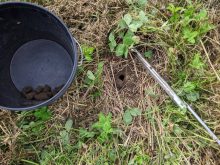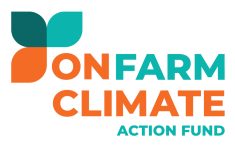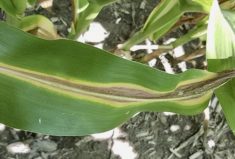Getting the most out of soil and tissue analysis involves timing, technique and knowing how to maximize the results.
A field with adequate fertility doesn’t necessarily equate to adequate plant nutrition, said Jack Legg, SGS Crop Science manager and agronomist, at Ontario Soil and Crop Improvement’s Microsmart Deep Dive presentation in Kingston.
Soil tests assess the potential availability of nutrients under optimal conditions. In contrast, tissue tests indicate actual uptake under variable field conditions.
Read Also

The forced Japanese-Canadian farmers of the Second World War
Manitoba’s sugar beet farms drew on displaced Japanese-Canadians from B.C. during the Second World War
“Non-limiting in the soil is where you want to be, but it doesn’t necessarily mean that the crop is utilizing it efficiently,” Legg explained. “Tissue samples tend to be reactionary. People see a deficiency; they want to confirm it. They send in the tissue.”
“We don’t really want to see deficiencies,” said Legg. “We want to test before things go deficient.”
According to him, tissue tests are a proactive nutrient management tool that identifies “hidden hunger” before it escalates into a critical issue.
Chris Roelands, president of Honeyland Ag Services, explained that soil sampling should follow the same schedule, ideally in the fall when soil moisture is sufficient, to provide comparable results on nutrient availability year over year.
“Soil testing is still the base of where everything starts, right?” he said, adding it’s the soil reserve baseline to inform needed inputs.
In general, soil testing in the fall provides ideal moisture levels for probing ease and nutrient accuracy.
Soil scientist Rigas Karamanos noted that research from the Saskatchewan Soil Testing and Enviro-Test Laboratories indicates that weather and soil moisture influence soil pH during the growing season. He explained that as the pH changes, which can be significant with soil moisture, the availability of nutrients also shifts. For example, potassium tends to bind to clay under drier conditions.
However, Roelands cautioned that three aspects — genetics, environment and management (G.E.M.) — can affect how plants convert soil nutrients.
“Soil moisture, temperature, or whether it’s something related to management, can be what changes what we see in our plant tissue test versus what we’re seeing in our soil test,” Roelands said.
For example, manganese availability and uptake are more efficient in compacted, saturated and anaerobic conditions, but those are terrible for other nutrient uptake.
The soil and tissue tests of V10 corn at approximately six feet tall show that, on average, potassium levels in the soil and tissue concentration rose in unison. However, a closer look at individual field sites revealed that soil sites with a less-than-desirable 60 ppm K level had plants with decent levels. Where plants tested poorly for potassium, the soil levels were decent.
This is where G.E.M. comes into play to provide answers on why that’s happening, said Roelands.
Legg said tissue testing throughout the growing season provides unique insights into the plant’s current needs at the juvenile, mid-season and flowering or silking stages to inform how to mitigate immediate issues and plan for the following season.
“The basic rule of thumb is to test as much, as frequently and as intensively as you’re willing to pay for obviously and willing to manage,” Legg suggested. “Starting with one or two tissues in a crop a year is a good starting point. Weekly is very interesting, but it’s a heck of a lot of data and a lot of work.”
There are a few easy rules to follow to ensure the best bang for your buck with tissue samples. The first is leaf quantity. Corn leaves are probably the easiest, but Legg suggested a third to half-full paper lunch bag for other crops.
“When we dry that down, that only leaves us with a few grams of dried material,” he explained. “One little soybean trifoliate is not enough to test.”
Due to nutrient mobility, the ideal sample is the most recent fully developed leaf, usually a few down from the top, wrapped in paper instead of plastic to avoid slimy samples.
“Identifying the growth stage (is important),” he added. “The critical values are usually tied to a physiological age, usually when the plant is under stress like flowering or silking. Make sure you label them appropriately.”
If selecting tissue samples for a v3 corn plant (which is rare), pull the entire plant cut at grade without roots, said Legg. Select the most recently collared leaf at the vegetative stage and the ear leaf at tasselling. Wheat follows a similar vein, with soybean, requiring the most recently mature trifoliate throughout the season.
He encouraged producers to provide a clean sample, cutting it as low as possible without soil contamination, which provides biased results.
“Folks think micronutrients are less important,” he shared. “They’re essential nutrients required for that whole plant life cycle, but in much smaller quantities.”
He said we’ve managed without fertilizing micronutrients for decades, but it’s becoming a soil management focal point, said Legg.
Ontario soils generally contain sufficient copper, iron, and molybdenum supplies but require micronutrients like zinc, manganese or boron, which has a narrow range between adequate and toxic. Legg said that integrating these in a proactive nutrient management program can optimize crop yield.
He suggested farmers try check and zero strip trials with varying rates to test the payback on their farms, noting a pound of zinc and manganese costs approximately four dollars, while a pound of boron is slightly more expensive at $7.25.
He explained that fertilizers can increase manganese levels over time, but application is crucial. Applying a foliar treatment to symptomatic soybeans, for example, is a quick fix, but fertilizing the leaves does not enhance soil fertility.
“The bottom line is, in general, if your (zinc and manganese) index value is greater than 15 ppm, you have enough nutrients,” said Legg. “(Boron levels of) 0.5 ppm is considered low, and 1.0 ppm is considered high.”















